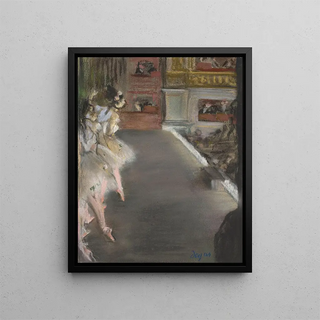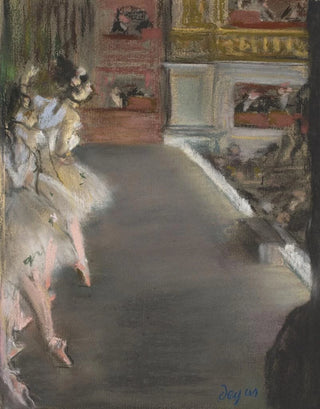Art print | Dancers at the Old Opera - Edgar Degas


View from behind

Frame (optional)
The 19th-century art scene is marked by iconic figures, among which Edgar Degas stands out for his unique approach to dance and movement. In his work "Danseurs au vieil opéra," he captures the essence of a fleeting moment, where grace and energy of the dancers blend with the subdued atmosphere of the opera. This painting, a true ode to the art of dance, transports us to a world where beauty and emotion meet. The art print Danseurs au vieil opéra - Edgar Degas invites an immersion into this universe, revealing the artist's mastery and keen eye on Parisian life.
Style and uniqueness of the work
Degas's style is characterized by meticulous attention to detail and bold use of light. In "Danseurs au vieil opéra," he plays with shadows and reflections to create an intimate atmosphere, where the viewer is almost a voyeur of this rehearsal scene. The bodies of the dancers, frozen in dynamic poses, testify to an impressive technique, where each movement is both captured and sublimated. Degas does not merely reproduce reality; he interprets it with a sensitivity that transcends simple visual representation. Warm colors and soft tones add an emotional dimension, while the composition, both balanced and dynamic, plunges us into the heart of the action. Every element of the painting contributes to a visual narration, where the movement and grace of the dancers intertwine in a captivating visual ballet.
The artist and his influence
Edgar Degas, often associated with the Impressionist movement, distinguished himself through his interest in unconventional subjects, such as dancers and scenes of daily life. His academic training allowed him to develop a rigorous technique, which he then enriched through personal experiences and meticulous observations. Degas's influence on modern art is undeniable, as he paved the way for a deeper exploration of form and movement. His works have inspired many artists, who saw in him a pioneer of dynamic representation. By approaching dance with a

Matte finish

View from behind

Frame (optional)
The 19th-century art scene is marked by iconic figures, among which Edgar Degas stands out for his unique approach to dance and movement. In his work "Danseurs au vieil opéra," he captures the essence of a fleeting moment, where grace and energy of the dancers blend with the subdued atmosphere of the opera. This painting, a true ode to the art of dance, transports us to a world where beauty and emotion meet. The art print Danseurs au vieil opéra - Edgar Degas invites an immersion into this universe, revealing the artist's mastery and keen eye on Parisian life.
Style and uniqueness of the work
Degas's style is characterized by meticulous attention to detail and bold use of light. In "Danseurs au vieil opéra," he plays with shadows and reflections to create an intimate atmosphere, where the viewer is almost a voyeur of this rehearsal scene. The bodies of the dancers, frozen in dynamic poses, testify to an impressive technique, where each movement is both captured and sublimated. Degas does not merely reproduce reality; he interprets it with a sensitivity that transcends simple visual representation. Warm colors and soft tones add an emotional dimension, while the composition, both balanced and dynamic, plunges us into the heart of the action. Every element of the painting contributes to a visual narration, where the movement and grace of the dancers intertwine in a captivating visual ballet.
The artist and his influence
Edgar Degas, often associated with the Impressionist movement, distinguished himself through his interest in unconventional subjects, such as dancers and scenes of daily life. His academic training allowed him to develop a rigorous technique, which he then enriched through personal experiences and meticulous observations. Degas's influence on modern art is undeniable, as he paved the way for a deeper exploration of form and movement. His works have inspired many artists, who saw in him a pioneer of dynamic representation. By approaching dance with a






